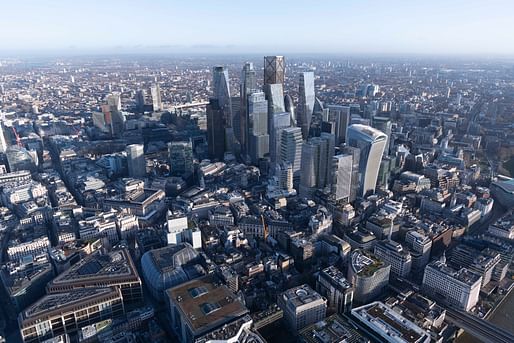

The City of London Corporation has revealed new images depicting the 2030 skyline of the Square Mile ahead of the completion of a planned cluster of tall buildings that are expected by the end of the decade.
The plans depicted include the 11-building ‘City Cluster’, which strategically closes an existing gap between Rafael Viñoly’s 20 Fenchurch Street (aka the “Walkie-Talkie" tower) and adjacent plots in the body's local plan. Other key areas of change included in the City Plan 2040 call for the construction of new pedestrian routes and public green space, added ground-level accommodations for retail, and a mix of education and cultural spaces.
“These new CGI images clearly illustrate the ever-changing nature of London's incredible skyline. It demonstrates that the City office is here to stay, and that the Square Mile's real estate sector is robust and thriving, despite wider economic concerns,” Chair of the Planning and Transportation Committee at the City of London Corporation, Shravan Joshi, said in a statement.
Forthcoming projects in the cluster include 3XN’s two-tower 2 Finsbury Avenue scheme, the new 55 Bishopsgate building by Arney Fender Katsalidis, Eric Parry Architects' proposed 1 Undershaft design, and eight others.
“Through our flagship ‘Destination City’ policy, we are creating a culturally vibrant, inclusive and welcoming City, enabled in part by these tall towers which help accommodate the hospitality, leisure, social and cultural destinations that are flocking to the City,” Joshi added. “The City Corporation’s strong performance this year is underpinned by the Built Environment team’s efforts to de-risk many of the variables associated with real estate investment. This includes providing clear policy directives, working closely with stakeholders, and undertaking transparent consultation on schemes.”
The City of London reports an increase of 29,000 workers in the district since 2021, with another 85,000 expected by the 2040 marker. Planned office space will comprise over 1 million square meters (more than 10.8 million square feet) by the end of the cycle. More details of the plan can be found here.
1 Comment
City Cluster or City Clutter? The buildings' distinctive features get lost in the crowd, in my view for the better in the case of several—the Walkie Talkie is tamed—but to the detriment of others. The overall effect lacks coherence and appeal. And all all buildings lose a significant proportion of a major asset, extended views. From the street, there is impacted chaos—see the picture in the post, above.
The tall skyscrapers that captured our imagination in the past were isolated, standing alone, so their features could be seen and appreciated throughout a city. The better ones were able to set a mark and a tone, the Chrysler Building, for example. London is still essentially flat and could have sustained similar treatment, with better design.
Block this user
Are you sure you want to block this user and hide all related comments throughout the site?
Archinect
This is your first comment on Archinect. Your comment will be visible once approved.